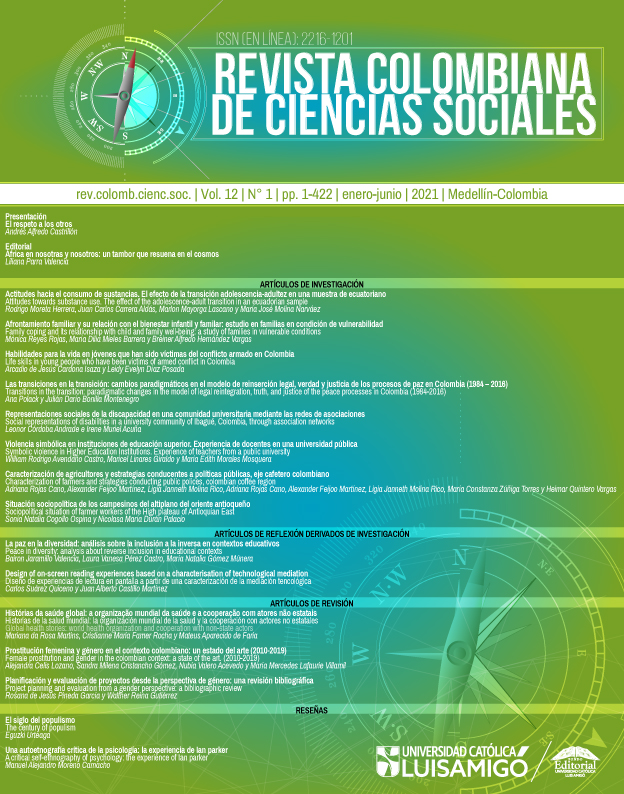Africa in us: A drum that resonates in the cosmos
DOI:
https://doi.org/10.21501/22161201.3847Abstract
Cumbia, bullerengue, black son and currulao are part of Africa's living heritage in Colombia; traces of Africania, as Nina de Friedemann (1992) meant, which reaffirm an ancient and original presence, among us. Musicality has been essential for studies and thinking about identity, black culture and the status of Afro-descendant communities in "Améfrica" (Du Bois, 1999; Zapata Olivella, 1962; Zapata Olivella, 2000; García, 1994; Miller, 2009; Segato, 1995; Mukuna, 1978; Quintero, 2000). This notion that it minted the afrobrasilian Léila Gonzalez (1988) it is accounted for the Africanization of the Americas, which includes the territories of the north, center, south and island (Caribbean).
Downloads
References
Cunha, H. (2010). Ntu: Introdução ao pensamento filosófico Bantu. Educação Em Debate, 1, 25–40.
Du Bois, W. (1999). As Sorrow Songs. En: As almas da gente negra [The Souls of Black Folk , 1903]. [Trad.]. Lacerda Editorial.
Escalante, A. (1989). Significado del Lumbalú, ritual funerario del Palenque de San Basilio. Huellas, 26, 11–24.
Ferreira, L. (2011). Guia para a prática coletiva de música Afro-brasileira, Africana e Afro-latino-americana. Universidad de Brasilia.
Friedemann, N. (1992). Huellas de africanía en Colombia. Nuevos escenarios de investigación. Thesaurus, XLVII, 543–560.
García, J. (1994). La contribución musical de África Subsahariana al mosaico musical de las Américas y los Caribes. Africamerica, 3, 21–24.
Gilroy, P. (2001). O Atlântico negro: modernidade e dupla consciência. 34 Editorial
Gonzalez, L. (1988). A categoria politico-cultural de amefricanidade. TB. Rio de Janeiro. 92/93, 69–82.
Machado, A. (2014). Filosofia africana para descolonizar olhares: perspectivas para o ensino das relações étnico-raciais. # Tear: Revista de Educação Ciência e Tecnologia, Canoas, 3(1), 1–20.
Miller, I. (2009). Voice of the Leopard. African Secret Societies and Cuba. The University Press of Mississippi.
Mukuna, K. (1978). Contribuição Bantu na música popular brasileira. Global Editora.
Navarrete, M. (2001). El cimarronaje, una alternativa de libertad para los esclavos negro. Historia Regional. Barranquilla, II (6), 89–98.
Pérez, M. (2014). El Bullerengue la génesis de la música de la Costa Caribe colombiana. El Artista, 11, 30–52. http://www.redalyc.org/articulo.oa?id=87432695002
Quintero, A. (2000). Baile y ciudadanía. En: La danza de la insurrección. (pp. 393–436). Ediciones Clacso.
Segato, R. (1995). Okarilé: Uma toada icônica de Iemanjá. Revista Do Patrimônio Histórico e Artístico Nacional, Brasília, 237–253.
Zapata Olivella, D. (1962). La cumbia. Síntesis musical de la nación colombiana. Reseña histórica y coreográfica. Revista Colombiana de Folclor, 3 (7), 187–204.
Zapata Olivella, M. (2000). Omnipresencia africana en la civilización universal. En: Palabra (Publication of the Afro-Latin/American Research Association). Afro-Romance Institute (University of Missouri-Columbia) & Department of African and African American Studies. Pennsylvania State University.
Downloads
Published
How to Cite
Issue
Section
License
Copyright (c) 2021 Revista Colombiana de Ciencias Sociales

This work is licensed under a Creative Commons Attribution-NonCommercial-NoDerivatives 4.0 International License.
La revista y los textos individuales que en esta se divulgan están protegidos por las leyes de copyright y por los términos y condiciones de la Licencia Creative Commons Atribución-No Comercial-Sin Derivar 4.0 Internacional.











